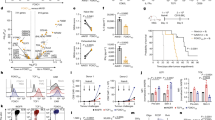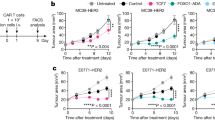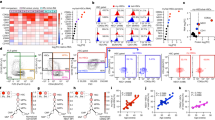Abstract
The humoral immune response requires that B cells undergo a sudden anabolic shift and high cellular nutrient levels, which are required to sustain the subsequent proliferative burst. Follicular lymphoma (FL) originates from B cells that have participated in the humoral response, and 15% of FL samples harbour point-activating mutations in RRAGC, an essential activator of mTORC1 downstream of the sensing of cellular nutrients. The impact of recurrent RRAGC mutations in B cell function and lymphoma is unexplored. RRAGC mutations, targeted to the endogenous locus in mice, confer a partial insensitivity to nutrient deprivation, but strongly exacerbate B cell responses and accelerate lymphomagenesis, while creating a selective vulnerability to pharmacological inhibition of mTORC1. This moderate increase in nutrient signalling synergizes with paracrine cues from the supportive T cell microenvironment that activate B cells via the PI3K–Akt–mTORC1 axis. Hence, Rragc mutations sustain induced germinal centres and murine and human FL in the presence of decreased T cell help. Our results support a model in which activating mutations in the nutrient signalling pathway foster lymphomagenesis by corrupting a nutrient-dependent control over paracrine signals from the T cell microenvironment.
This is a preview of subscription content, access via your institution
Access options
Access Nature and 54 other Nature Portfolio journals
Get Nature+, our best-value online-access subscription
$29.99 / 30 days
cancel any time
Subscribe to this journal
Receive 12 digital issues and online access to articles
$119.00 per year
only $9.92 per issue
Buy this article
- Purchase on Springer Link
- Instant access to full article PDF
Prices may be subject to local taxes which are calculated during checkout






Similar content being viewed by others
Data availability
Sequence data that support the findings of this study have been deposited in GEO, with the accession codes GSE125393 and GSE125394. The data that support the findings of this study are available from the corresponding author upon request. The data that support the plots within this paper and other findings of this study are available from the corresponding author upon reasonable request.
References
Kahl, B. D. & Yang, D. T. Follicular lymphoma: evolving therapeutic strategies. Blood 127, 2055–2063 (2016).
Victora, G. D. & Nussenzweig, M. C. Germinal centers. Annu. Rev. Immunol. 30, 429–457 (2012).
Shlomchik, M. J. & Weisel, F. Germinal center selection and the development of memory B and plasma cells. Immunol. Rev. 247, 52–63 (2012).
Mesin, L., Ersching, J. & Victora, G. D. Germinal center B cell dynamics. Immunity 45, 471–482 (2016).
Bannard, O. & Cyster, J. G. Germinal centers: programmed for affinity maturation and antibody diversification. Curr. Opin. Immunol. 45, 21–30 (2017).
Tas, J. et al. Visualizing antibody affinity maturation in germinal centers. Science 351, 1048–1054 (2016).
de Jong, D. & Fest, T. The microenvironment in follicular lymphoma. Best Pract. Res. Clin. Haematol. 24, 135–146 (2011).
Huet, S., Sujobert, P. & Salles, G. From genetics to the clinic: a translational perspective on follicular lymphoma. Nat. Rev. Cancer 18, 224–239 (2018).
Pasqualucci, L. et al. Genetics of follicular lymphoma transformation. Cell Rep. 6, 130–140 (2014).
Pasqualucci, L. et al. Inactivating mutations of acetyltransferase genes in B-cell lymphoma. Nature 471, 189–195 (2011).
Morin, R. D. et al. Frequent mutation of histone-modifying genes in non-Hodgkin lymphoma. Nature 476, 298–303 (2011).
Morin, R. D. et al. Somatic mutations altering EZH2 (Tyr641) in follicular and diffuse large B-cell lymphomas of germinal-center origin. Nat. Genet. 42, 181–185 (2010).
Okosun, J. et al. Integrated genomic analysis identifies recurrent mutations and evolution patterns driving the initiation and progression of follicular lymphoma. Nat. Genet 46, 176–181 (2014).
Boice, M. et al. Loss of the HVEM tumor suppressor in lymphoma and restoration by modified CAR-T cells. Cell 167, 405–418 (2016).
Challa-Malladi, M. et al. Combined genetic inactivation of β2-microglobulin and CD58 reveals frequent escape from immune recognition in diffuse large B cell lymphoma. Cancer Cell 20, 728–740 (2011).
Cheung, K. J. J. et al. Acquired TNFRSF14 mutations in follicular lymphoma are associated with worse prognosis. Cancer Res. 70, 9166–9174 (2010).
Kridel, R. et al. Histological transformation and progression in follicular lymphoma: a clonal evolution study. PLoS Med. 13, e1002197 (2016).
Launay, E. et al. High rate of TNFRSF14 gene alterations related to 1p36 region in de novo follicular lymphoma and impact on prognosis. Leukemia 26, 559–562 (2012).
Ying, Z. X. et al. Recurrent mutations in the MTOR regulator RRAGC in follicular lymphoma. Clin. Cancer Res. 22, 5383–5393 (2016).
Okosun, J. et al. Recurrent mTORC1-activating RRAGC mutations in follicular lymphoma. Nat. Genet. 48, 183–188 (2016).
Green, M. R. et al. Mutations in early follicular lymphoma progenitors are associated with suppressed antigen presentation. Proc. Natl Acad. Sci. USA 112, E1116–E1125 (2015).
Ben-Sahra, I. & Manning, B. D. mTORC1 signaling and the metabolic control of cell growth. Curr. Opin. Cell Biol. 45, 72–82 (2017).
Efeyan, A., Comb, W. C. & Sabatini, D. M. Nutrient-sensing mechanisms and pathways. Nature 517, 302–310 (2015).
Kim, E., Goraksha-Hicks, P., Li, L., Neufeld, T. P. & Guan, K. L. Regulation of TORC1 by Rag GTPases in nutrient response. Nat. Cell Biol. 10, 935–945 (2008).
Sancak, Y. et al. The Rag GTPases bind raptor and mediate amino acid signaling to mTORC1. Science 320, 1496–1501 (2008).
Shen, K., Choe, A. & Sabatini, D. M. Intersubunit crosstalk in the Rag GTPase heterodimer enables mTORC1 to respond rapidly to amino acid availability. Mol. Cell 68, 552–565 (2017).
Shimobayashi, M. & Hall, M. N. Making new contacts: the mTOR network in metabolism and signalling crosstalk. Nat. Rev. Mol. Cell Biol. 15, 155–162 (2014).
Valvezan, A. J. & Manning, B. D. Molecular logic of mTORC1 signalling as a metabolic rheostat. Nat. Metab. 1, 321–333 (2019).
Tsun, Z. Y. et al. The folliculin tumor suppressor is a GAP for the RagC/D GTPases that signal amino acid levels to mTORC1. Mol. Cell 52, 495–505 (2013).
Wang, H. et al. One-step generation of mice carrying mutations in multiple genes by CRISPR/cas-mediated genome engineering. Cell 153, 910–918 (2013).
Efeyan, A. et al. Regulation of mTORC1 by the Rag GTPases is necessary for neonatal autophagy and survival. Nature 493, 679–683 (2013).
Hara, K. et al. Amino acid sufficiency and mTOR regulate p70 S6 kinase and eIF-4E BP1 through a common effector mechanism. J. Biol. Chem. 273, 14484–14494 (1998).
Wang, S. et al. Metabolism. Lysosomal amino acid transporter SLC38A9 signals arginine sufficiency to mTORC1. Science 347, 188–194 (2015).
Egle, A., Harris, A. W., Bath, M. L., O’Reilly, L. & Cory, S. VavP-Bcl2 transgenic mice develop follicular lymphoma preceded by germinal center hyperplasia. Blood 103, 2276–2283 (2004).
Subramanian, A. et al. Gene set enrichment analysis: a knowledge-based approach for interpreting genome-wide expression profiles. Proc. Natl Acad. Sci. USA 102, 15545–15550 (2005).
Ersching, J. et al. Germinal center selection and affinity maturation require dynamic regulation of mTORC1 kinase. Immunity 46, 1045–1058 (2017).
Kitamura, D., Roes, J., Kuhn, R. & Rajewsky, K. A. B cell-deficient mouse by targeted disruption of the membrane exon of the immunoglobulin μ chain gene. Nature 350, 423–426 (1991).
Calado, D. P. et al. The cell-cycle regulator c-Myc is essential for the formation and maintenance of germinal centers. Nat. Immunol. 13, 1092–1100 (2012).
Dominguez-Sola, D. et al. The proto-oncogene MYC is required for selection in the germinal center and cyclic reentry. Nat. Immunol. 13, 1083–1091 (2012).
Krysiak, K. et al. Recurrent somatic mutations affecting B-cell receptor signaling pathway genes in follicular lymphoma. Blood 129, 473–483 (2017).
Peng, T., Golub, T. R. & Sabatini, D. M. The immunosuppressant rapamycin mimics a starvation-like signal distinct from amino acid and glucose deprivation. Mol. Cell Biol. 22, 5575–5584 (2002).
Murakami, M. et al. mTOR is essential for growth and proliferation in early mouse embryos and embryonic stem cells. Mol. Cell. Biol. 24, 6710–6718 (2004).
Thoreen, C. C. et al. An ATP-competitive mammalian target of rapamycin inhibitor reveals rapamycin-resistant functions of mTORC1. J. Biol. Chem. 284, 8023–8032 (2009).
Feldman, M. E. et al. Active-site inhibitors of mTOR target rapamycin-resistant outputs of mTORC1 and mTORC2. PLoS Biol. 7, e38 (2009).
Zoncu, R., Efeyan, A. & Sabatini, D. M. mTOR: from growth signal integration to cancer, diabetes and ageing. Nat. Rev. Mol. Cell Biol. 12, 21–35 (2011).
Luo, W., Weisel, F. & Shlomchik, M. J. B. B cell receptor and CD40 signaling are rewired for synergistic induction of the c-Myc transcription factor in germinal center B cells. Immunity 48, 313–326 (2018).
Han, S. et al. Cellular interaction in germinal centers. Roles of CD40 ligand and B7-2 in established germinal centers. J. Immunol. 155, 556–567 (1995).
Papa, I. & Vinuesa, C. G. Synaptic interactions in germinal centers. Front. Immunol. 9, 1858 (2018).
Vinuesa, C. G. & Cyster, J. G. How T cells earn the follicular rite of passage. Immunity 35, 671–680 (2011).
Vinuesa, C. G., Linterman, M. A., Yu, D. & MacLennan, I. C. M. Follicular helper T cells. Annu. Rev. Immunol. 34, 335–368 (2016).
Qi, H., Cannons, J. L., Klauschen, F., Schwartzberg, P. L. & Germain, R. N. SAP-controlled T–B cell interactions underlie germinal centre formation. Nature 455, 764–769 (2008).
Zoncu, R. et al. mTORC1 senses lysosomal aminoacids through an inside-out mechanism that requires the vacuolar H+-ATPase. Science 334, 678–683 (2011).
Efeyan, A. et al. RagA, but not RagB, is essential for embryonic development and adult mice. Dev. Cell 29, 321–329 (2014).
Boothby, M. & Rickert, R. C. Metabolic regulation of the immune humoral response. Immunity 46, 742–755 (2017).
Heise, N. et al. Germinal center B cell maintenance and differentiation are controlled by distinct NF-κB transcription factor subunits. J. Exp. Med. 211, 2103–2118 (2014).
Dowling, R. J. O. et al. mTORC1-mediated cell proliferation, but not cell growth, controlled by the 4E-BPs. Science 328, 1172–1176 (2010).
Barbet, N. C. et al. TOR controls translation initiation and early G1 progression in yeast. Mol. Biol. Cell 7, 25–42 (1996).
Smith, S. M. et al. Temsirolimus has activity in non-mantle cell non-Hodgkin’s lymphoma subtypes: The University of Chicago phase II consortium. J. Clin. Oncol. 28, 4740–4746 (2010).
Bannani, N. N. et al. Efficacy of the oral mTORC1 inhibitor everolimus in relapsed or refractory indolent lymphoma. Am. J. Hematol. 92, 448–453 (2017).
Witzig, T. E. et al. A phase II trial of the oral mTOR inhibitor everolimus in relapsed aggressive lymphoma. Leukemia 25, 341–347 (2011).
Willett, E. V. et al. Non‐Hodgkin lymphoma and obesity: a pooled analysis from the InterLymph Consortium. Int. J. Cancer 122, 2062–2070 (2008).
Renehan, A. G., Tyson, M., Egger, M., Heller, R. F. & Zwahlen, M. Body-mass index and incidence of cancer: a systematic review and meta-analysis of prospective observational studies. Lancet 371, 569–578 (2008).
Bhaskaran, K. et al. Body-mass index and risk of 22 specific cancers: a population-based cohort study of 5.24 million UK adults. Lancet 384, 755–765 (2014).
The Global BMI Mortality Collaboration Body-mass index and all-cause mortality: individual-participant-data meta-analysis of 239 prospective studies in four continentsThe Global BMI Mortality Collaboration †Show footnotes. Lancet 388, 776–786 (2016).
Kosaraju, R. et al. B cell activity is impaired in human and mouse obesity and is responsive to an essential fatty acid upon murine influenza infection. J. Immunol. 198, 4738–4752 (2017).
Sheridan, P. A. et al. Obesity is associated with impaired immune response to influenza vaccination in humans. Int. J. Obes. (Lond.) 36, 1072–1077 (2012).
Zhang, J. et al. The CREBBP acetyltransferase is a haploinsufficient tumor suppressor in B-cell lymphoma. Cancer Discov. 7, 322–337 (2017).
Trapnell, C. et al. Differential gene and transcript expression analysis of RNA-seq experiments with TopHat and Cufflinks. Nat. Protoc. 7, 562–578 (2012).
Langmead, B., Trapnell, C., Pop, M. & Salzberg, S. Ultrafast and memory-efficient alignment of short DNA sequences to the human genome. Genome Biol. 10, R25 (2009).
Li, H. et al. The Sequence Alignment/Map format and SAMtools. Bioinformatics 25, 2078–2079 (2009).
Love, M. I., Huber, W. & Anders, S. Moderated estimation of fold change and dispersion for RNA-seq data with DESeq2. Genome Biol. 15, 550 (2014).
Carreras, J. et al. High numbers of tumor-infiltrating programmed cell death 1-positive regulatory lymphocytes are associated with improved overall survival in follicular lymphoma. J. Clin. Oncol. 27, 1470–1476 (2009).
Carreras, J. et al. Genomic profile and pathologic features of diffuse large b-cell lymphoma subtype of methotrexate-associated lymphoproliferative disorder in rheumatoid arthritis patients. Am. J. Surg. Pathol. 42, 936–950 (2018).
Acknowledgements
We are indebted to D. M. Sabatini (R01 CA129105, R01 CA103866 and R37 AI047389) and thank R. Jaenisch, S. Markoulaki and the Whitehead Institute for Biomedical Research CRISPR facility for zygote injections. We thank A. Clear and K. Korfi for generating TMAs from lymphoma patients, and P. A. Katajisto for critical reading of the manuscript. We also thank CNIO Flow Cytometry, Histopathology, Animal Facility and Genomics Core Units for excellent technical support. Research was supported by the RETOS projects Programme of Spanish Ministry of Science, Innovation and Universities, Spanish State Research Agency, cofunded by the European Regional Development Fund (grant SAF2015-67538-R), EU-H2020 Programme (ERC-2014-STG-638891), Excellence Network Grant from MICIU/AEI (SAF2016-81975-REDT), a Ramon y Cajal Award from MICIU/AEI (RYC-2013-13546), Spanish Association Against Cancer Research Scientific Foundation Laboratory Grant, Beca de Investigación en Oncología Olivia Roddom, FERO Grant for Research in Oncology; Miguel Servet Fellowship and Grant Award (MS16/00112 and CP16/00112) and Project PI18/00816 within the Health Strategic Action from the ISCIII (to A.O.-M.), both cofunded by the European Regional Development Fund, Marcos Fernandez Fellowship from the Spanish Leukaemia and Lymphoma Foundation/Vistare Foundation (to A.O.-M.) and L’Oreal For Women in Science Award (to A.O.-M.). J.F. is a recipient of a Cancer Research UK Programme Award (15968) and J.O. is a recipient of a Cancer Research UK Clinician Scientist Fellowship (22742). N.M.-M. is a Ramon y Cajal Awardee MICIU/AEI (RYC-2016-20173). N.D.-S., C.C.A., A.B.P.-G. and K.T. are recipients of Ayudas de contratos predoctorales para la formacion de doctores from MICIU/AEI (BES-2016-077410, BES-2015-073776, BES-2017−081381, BES-2016-078082).
Author information
Authors and Affiliations
Contributions
A.O.-M. performed most experiments, contributed to experimental design, data analysis and writing of the manuscript. N.D.-S, A.S., C.L.-F, C.M., C.C.A., A.V., L.M.-A, B.F.-R, A.B.P-G. and N.M.-M. provided help with experimentation. K.T. and E.P.-Y. performed bioinformatics analysis of RNA-seq and meta-analysis of mutually exclusive mutations. E.C. and A.D.M. performed and diagnosed the histology and pathology. J.C. and N.N. performed and analysed immunohistochemistry studies on human samples. S.A., J.O. and J.F. performed the mutation analyses on the patient samples, provided the corresponding tissue microarrays and clinical information. J.O., J.F. and G.D.V. contributed critical intellectual input in design and interpretation of data. A.E. conceived and supervised the study, analysed the data, wrote the manuscript and secured funding. All authors read and commented on the manuscript and figures.
Corresponding author
Ethics declarations
Competing interests
The authors declare no competing interests.
Additional information
Peer review information: Primary Handling Editor: Ana Mateus.
Publisher’s note: Springer Nature remains neutral with regard to jurisdictional claims in published maps and institutional affiliations.
Supplementary information
Supplementary Information
Supplementary Figs. 1–7 and Tables 1–3
Rights and permissions
About this article
Cite this article
Ortega-Molina, A., Deleyto-Seldas, N., Carreras, J. et al. Oncogenic Rag GTPase signalling enhances B cell activation and drives follicular lymphoma sensitive to pharmacological inhibition of mTOR. Nat Metab 1, 775–789 (2019). https://doi.org/10.1038/s42255-019-0098-8
Received:
Accepted:
Published:
Issue Date:
DOI: https://doi.org/10.1038/s42255-019-0098-8
This article is cited by
-
Micropeptides: potential treatment strategies for cancer
Cancer Cell International (2024)
-
Raptor mediates the selective inhibitory effect of cardamonin on RRAGC-mutant B cell lymphoma
BMC Complementary Medicine and Therapies (2023)
-
The follicular lymphoma epigenome regulates its microenvironment
Journal of Experimental & Clinical Cancer Research (2022)
-
Limited survival and impaired hepatic fasting metabolism in mice with constitutive Rag GTPase signaling
Nature Communications (2021)
-
Losing control of nutrient sensing in the germinal centre drives lymphomagenesis
Nature Metabolism (2019)



